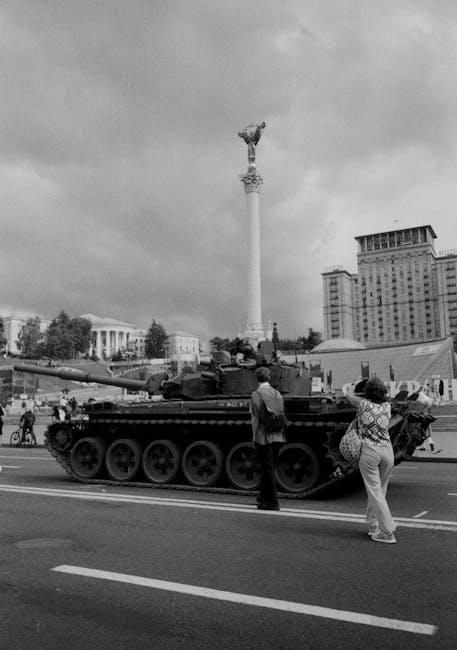Urban warfare presents unique challenges for tank tactics, requiring coordination with infantry, adaptability, and advanced technology. Historical lessons and modern strategies are crucial for success.
1.1 Overview of Urban Warfare Challenges
Urban warfare poses unique challenges, including narrow streets, tall buildings, and dense populations, which limit tank mobility and create ambush opportunities. Anti-tank weapons and improvised traps threaten armored vehicles, while civilians complicate operational strategies. These factors demand precise coordination with infantry and engineering units to mitigate risks and maintain tactical advantage in densely populated environments.
1.2 Importance of Tank Tactics in Urban Environments
Tank tactics are crucial in urban warfare due to their firepower and ability to support infantry in dense, high-threat environments. Effective strategies ensure tanks navigate confined spaces, avoid ambushes, and coordinate with ground forces. Advanced tactics, such as flanking and cover usage, mitigate risks and enhance operational success in these challenging settings.
Key Principles of Tank Tactics in Urban Warfare
Urban tank tactics emphasize coordination with infantry, utilizing cover, situational awareness, and precision strikes to overcome anti-tank threats and navigate complex environments effectively.
2.1 Utilizing Cover and Concealment in Urban Terrain
Urban terrain offers natural cover and concealment, such as buildings, narrow streets, and rubble, which tanks can exploit to avoid exposure. Effective use of cover minimizes vulnerability to anti-tank weapons, while concealment disrupts enemy targeting. However, the density of urban environments often limits visibility, requiring constant repositioning to maintain tactical advantage and avoid bottlenecks. Proper exploitation enhances survivability and operational success.
2.2 Coordination Between Tanks and Infantry Units
Effective coordination between tanks and infantry is critical in urban warfare, as tanks provide heavy firepower while infantry offers agility and precision. Tanks can suppress enemy positions, enabling infantry to advance safely. In return, infantry units can identify and neutralize anti-tank threats, ensuring mutual protection. Integrated tactics enhance mission success and reduce risks in densely populated urban environments.
2.3 Mobility and Positioning in Narrow Urban Streets
Urban streets pose significant challenges for tank mobility due to narrow passages and tight corners. Precise positioning is crucial to avoid bottlenecks and maintain operational flexibility. Tanks must navigate carefully to utilize cover while ensuring fields of fire. Advanced navigation systems and real-time reconnaissance help mitigate these challenges, enabling effective maneuvering in confined urban environments.
Anti-Tank Threats in Urban Warfare
Anti-tank missiles, IEDs, and guerrilla tactics pose significant risks in urban combat. Narrow streets and ambush points make tanks vulnerable to precision strikes and asymmetric warfare.
3.1 Common Anti-Tank Weapons in Urban Environments
Anti-tank weapons in urban warfare include portable missile systems, RPGs, and improvised explosive devices (IEDs). These weapons exploit narrow streets and buildings for ambushes, targeting tank vulnerabilities. Urban terrain allows guerrilla forces to use terrain features for concealment, making anti-tank missiles and roadside bombs highly effective against armored vehicles in confined spaces.
3.2 Effective Countermeasures Against Anti-Tank Missiles
Effective countermeasures include active protection systems, thermal imaging for early detection, and deploying flares to disrupt missile guidance. Smoke screens and rapid repositioning can also neutralize threats. Coordination with infantry units to identify and eliminate launch points enhances survivability. Modern tanks increasingly rely on advanced armor and electronic countermeasures to mitigate anti-tank missile threats in urban environments;
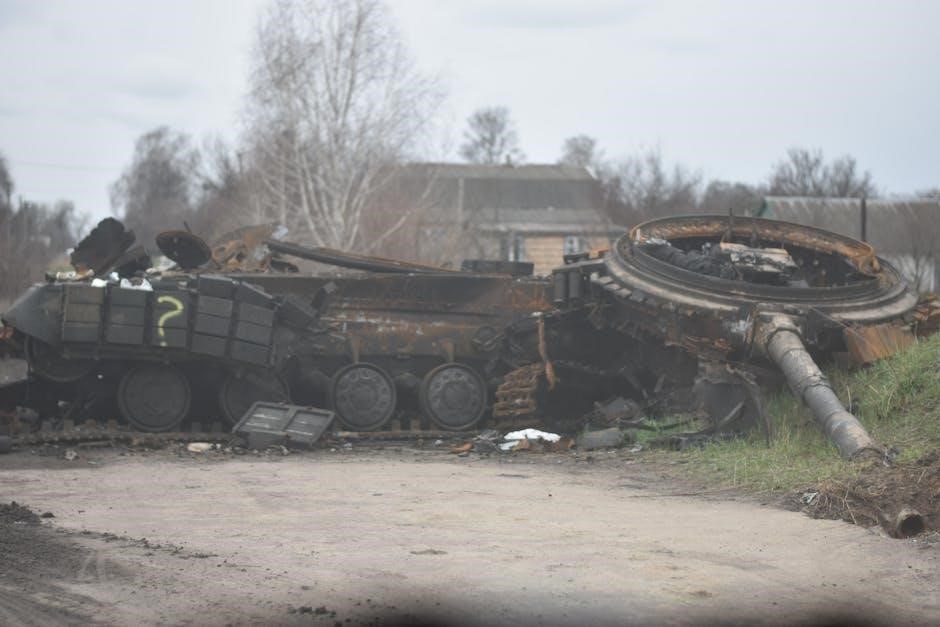
Historical Examples of Tank Tactics in Urban Warfare
Historical battles like Stalingrad and Berlin highlight the challenges of urban tank warfare, emphasizing coordination with infantry and adaptability in densely populated environments.
4.1 Lessons from World War II Urban Battles
World War II urban battles, such as Stalingrad and Berlin, revealed the challenges of tank warfare in densely populated areas. Tanks faced narrow streets, ambushes, and limited visibility, requiring close coordination with infantry. Historical lessons emphasize the need for combined arms tactics, adaptability, and cautious advancement to mitigate urban terrain risks and minimize casualties.
4.2 Modern Examples: Tank Warfare in Ukraine
The conflict in Ukraine highlights the challenges of modern urban tank warfare. Anti-tank missiles have significantly impacted tank tactics, forcing adaptations in mobility and coordination with infantry. Urban environments constrain tank movements, emphasizing the need for precision strikes and strategic positioning. These modern battles underscore the evolving nature of tank warfare and the importance of advanced countermeasures in densely populated areas.
Advanced Tactics for Urban Tank Operations
Advanced tactics include night operations with thermal imaging, ambush strategies, and flanking maneuvers, enhancing urban tank effectiveness while minimizing vulnerabilities in densely populated environments.
5.1 Night Operations and Use of Thermal Imaging
Night operations in urban warfare require specialized tactics, with thermal imaging systems enabling tanks to detect hidden threats and navigate through darkness. This technology enhances situational awareness, allowing precise targeting and coordination with infantry. Thermal imaging also reduces ambush risks, enabling tanks to operate effectively in low-visibility environments, a critical advantage in densely populated urban zones.
5;2 Ambush Tactics and Flanking Maneuvers
Ambush tactics in urban warfare exploit narrow streets and alleyways to target tanks with anti-tank missiles and IEDs. Flanking maneuvers involve coordinating with infantry to outflank attackers, using cover to surprise enemies. Effective urban ambushes require precise planning and coordination, leveraging terrain to offset tank vulnerabilities. These tactics highlight the importance of adaptability and situational awareness in dense urban environments.
Future Trends in Urban Tank Warfare
Technological advancements, including thermal imaging and AI integration, are revolutionizing urban tank warfare, enabling better navigation and precision in densely populated environments.
6.1 Technological Advancements in Tank Design
Modern tank designs incorporate thermal imaging, AI-driven systems, and reactive armor to enhance survivability in urban environments. Advanced propulsion systems improve mobility in narrow streets, while modular designs allow for tailored configurations. These innovations address the unique challenges of urban warfare, ensuring tanks remain effective in future conflicts.
6.2 Integration of Drones and AI in Urban Warfare
Drones and AI enhance urban tank operations by providing real-time intelligence, improving targeting accuracy, and enabling predictive analytics. AI systems optimize tactical decisions, while drones conduct reconnaissance, detect threats, and guide precision strikes. This integration revolutionizes urban warfare, allowing tanks to operate more effectively in complex, dynamic environments while mitigating traditional vulnerabilities such as ambushes and IEDs.
Training and Doctrine for Urban Tank Warfare
Effective urban tank warfare requires specialized training and doctrine, emphasizing coordination with infantry, situational awareness, and adaptive tactics. Military manuals and simulation tools enhance preparedness for complex urban scenarios.
7.1 Military Manuals and Guidelines for Urban Tank Tactics
Military manuals outline essential frameworks for urban tank operations, emphasizing coordination with infantry, situational awareness, and adaptive tactics. Doctrine addresses anti-tank threats, terrain challenges, and precision strikes, ensuring effective engagement. Guidelines stress the importance of training, joint operations, and technological integration to enhance urban warfare readiness and tactical execution in complex environments.
7.2 Simulation Training for Urban Warfare Scenarios
Simulation training is vital for preparing tank crews in urban warfare scenarios. Advanced simulators replicate complex environments, enabling realistic combat drills. Crews practice navigation, threat detection, and coordinated tactics. These exercises enhance decision-making and teamwork under pressure. Simulation also reduces risks and costs, ensuring readiness for real-world urban operations without live-fire constraints.
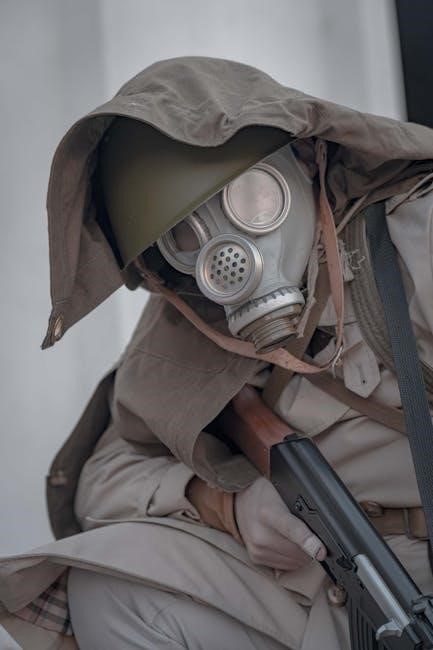
Coordination with Other Military Branches
Coordination with air support and engineering units enhances urban tank operations. Air provides reconnaissance and strikes, while engineers modify terrain, optimizing tank maneuvers and mission success.
8.1 Joint Operations with Air Support
Joint operations with air support significantly enhance urban tank tactics. Air reconnaissance identifies enemy positions, while precision strikes neutralize threats. Coordination ensures real-time intelligence sharing, enabling tanks to maneuver effectively and avoid anti-tank missile risks.
8.2 Engineering Support for Urban Terrain Modification
Engineering units play a vital role in modifying urban terrain to facilitate tank operations. They clear pathways, demolish obstacles, and create alternative routes, ensuring tank mobility. Engineers also assess structural integrity to prevent collapses. Their efforts enable tanks to maneuver effectively, avoid bottlenecks, and maintain operational tempo in densely populated areas while reducing risks from environmental hazards like flooded zones.
Psychological Impact of Tanks in Urban Warfare
Tanks in urban warfare exert significant psychological effects, intimidating enemy forces and civilians. Their presence enhances friendly troop morale while undermining adversary confidence, shaping battlefield dynamics.
9;1 Intimidation Factor and Morale Effects
Tanks in urban warfare wield a powerful psychological impact, intimidating enemy forces and civilians alike. Their presence boosts friendly morale, while undermining adversary confidence, creating a strategic advantage. The sheer force and visibility of tanks can deter resistance, instill fear, and disrupt enemy coordination, making them a crucial element in shaping battlefield psychology and dynamics effectively.
9.2 Civilian Considerations and Minimizing Collateral Damage
Urban tank operations require careful planning to minimize civilian casualties and property damage. Precision targeting, restricted use of high-explosive rounds, and evacuation protocols are essential. Modern conflicts highlight the need for adherence to international humanitarian law, ensuring proportionality in force. Post-conflict reconstruction efforts further emphasize the importance of balancing military objectives with civilian safety and infrastructure preservation in densely populated areas.
Urban Terrain and Its Impact on Tank Mobility
Urban terrain poses significant mobility challenges for tanks due to narrow streets, alleyways, and potential bottlenecks, requiring precise navigation and strategic positioning to avoid vulnerabilities.
10.1 Navigating Narrow Streets and Alleyways
Navigating narrow urban streets and alleyways requires precise maneuvering, reduced speed, and heightened situational awareness. Tanks must avoid tight corners and use infantry scouts to identify potential bottlenecks. Advanced reconnaissance and real-time feedback are essential to prevent entrapment. Engineers often clear paths, while thermal imaging aids in detecting hidden threats like IEDs. Coordination with supporting units ensures safe passage through densely built environments.
10.2 Avoiding Bottlenecks and Kill Zones
Avoiding bottlenecks and kill zones in urban warfare is critical for tank survival. Pre-reconnaissance, detailed mapping, and real-time intelligence help identify chokepoints. Tanks should avoid funnel points like bridges or narrow intersections, where anti-tank weapons are often concentrated. Engineering units clear alternative routes, while infantry provides overwatch to neutralize ambush points. Historical examples highlight the importance of rapid maneuvering to escape lethal zones.
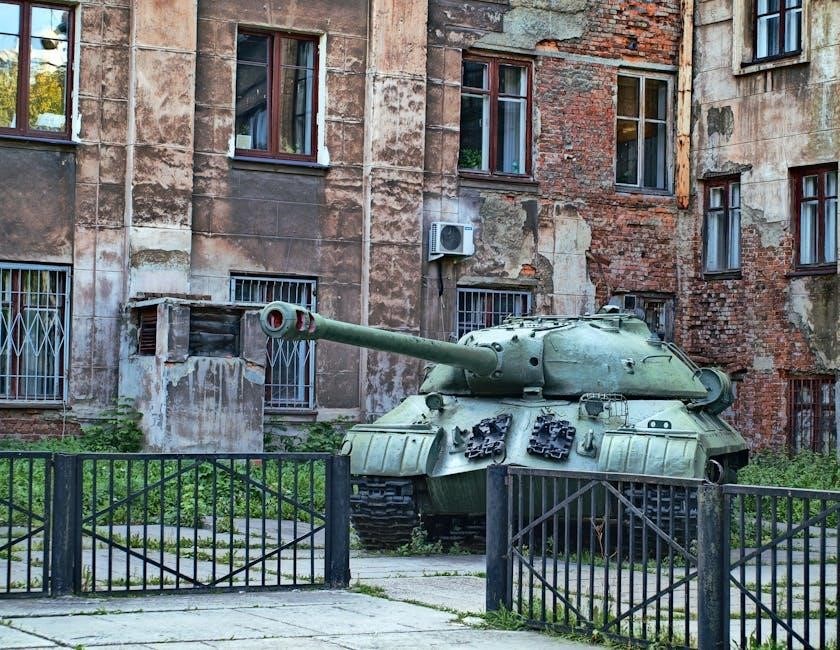
Guerrilla Warfare Tactics Against Tanks
Guerrilla forces employ asymmetric strategies, including IEDs, ambushes, and hit-and-run attacks, to neutralize tanks in urban environments, exploiting terrain and psychological impact to counter superior armor.
11.1 Asymmetric Warfare Strategies
Guerrilla forces use unconventional tactics, leveraging urban terrain to counter tanks through ambushes and IEDs. These strategies exploit the limitations of armor in densely populated areas, focusing on hit-and-run attacks to disrupt operations and undermine enemy morale. Urban environments provide cover for asymmetric warfare, allowing irregular forces to challenge conventional military superiority effectively.
11.2 Improvised Explosive Devices (IEDs) and Traps
Improvised Explosive Devices (IEDs) and traps are key tools in asymmetric warfare, often used to target tanks in urban environments. These devices exploit the confined terrain, causing significant damage and immobilizing armor. Guerrilla forces employ IEDs in narrow streets and alleyways, creating deadly bottlenecks. Such tactics disrupt operations, forcing conventional forces to adopt cautious strategies and undermining their mobility in densely populated areas.
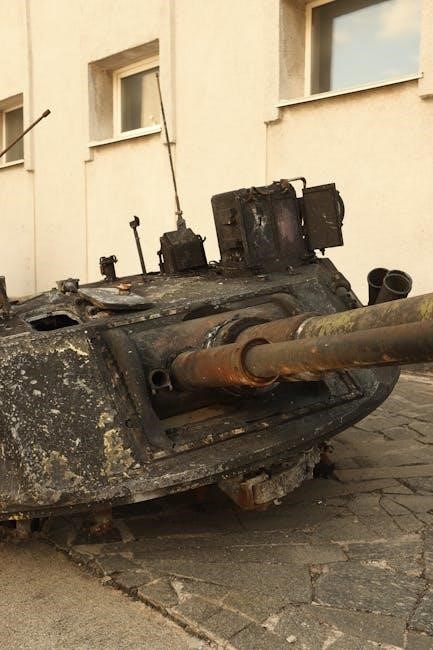
Urban Warfare Case Studies
Historical battles like Stalingrad and Berlin highlight the intensity of urban tank warfare, while modern conflicts in Ukraine demonstrate evolving tactics and challenges in densely populated areas.
12.1 Historical Battles: Stalingrad and Berlin
The battles of Stalingrad and Berlin during World War II showcased the brutal nature of urban warfare. Tanks faced significant challenges in narrow streets, with limited maneuverability and heightened vulnerability to anti-tank weapons. These conflicts emphasized the importance of infantry-tank coordination and the devastating impact of urban terrain on armored operations, providing invaluable lessons for modern tactics.
12.2 Modern Conflicts: Tank Warfare in Urban Centers
Modern urban conflicts, such as those in Ukraine, highlight the evolving role of tanks in dense city environments. The proliferation of anti-tank missiles has increased threats, forcing adaptive tactics like precision strikes and enhanced coordination with infantry. Urban tank warfare now emphasizes minimizing collateral damage while leveraging advanced technology to navigate and dominate congested battlefields effectively.
Urban tank warfare continues to evolve, with technological advancements and adaptive tactics shaping future conflicts. The integration of drones, AI, and precision weaponry will redefine urban battlefield strategies.
13.1 Evolving Nature of Urban Tank Warfare
Urban tank warfare is evolving rapidly, driven by technological advancements and shifting tactical demands. Modern conflicts highlight the need for adaptable strategies, integrating drones, AI, and precision weaponry. Historical lessons from WWII to Ukraine underscore the importance of versatility in urban environments. Anti-tank missiles and asymmetric tactics now challenge traditional armored dominance, necessitating advanced countermeasures and innovative doctrines for future engagements.
13.2 The Role of Tanks in Future Urban Conflicts
Tanks will remain critical in future urban conflicts despite evolving anti-tank threats. Technological advancements like reactive armor, drones, and AI will enhance their survivability and precision. Urban environments demand versatile tanks capable of coordinated operations with infantry and air support. As warfare intensity grows, tanks must adapt to navigate narrow streets, avoid IEDs, and integrate with modern battlefield systems for sustained effectiveness in densely populated areas.
